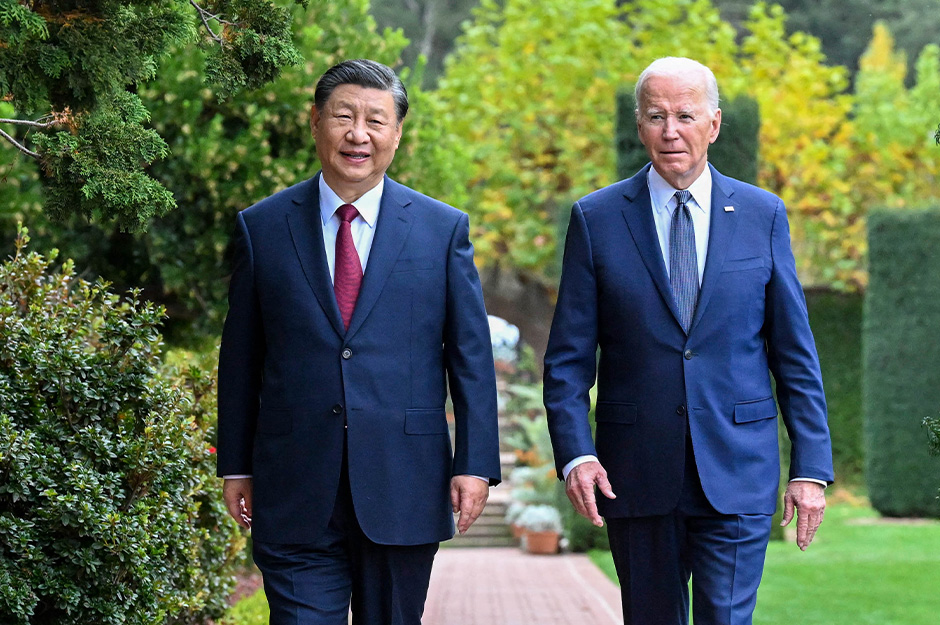
On November 15, 2023, Presidents Biden and Xi Jinping held four hours of official talks at a secluded estate south of San Francisco. This was their first in-person meeting in more than a year, since the last meeting in Bali, Indonesia.
In the interim, much has occurred in the bilateral relationship—both negative and positive. On the negative side, the Chinese spy balloon incident set back a planned schedule of governmental exchanges intended to restore dialogue and some degree of normalcy to the fragile relationship. On the positive side, after the passage of many months, these exchanges resumed slowly over the summer with several senior U.S. officials visiting Beijing.
From the Biden administration’s perspective, the purpose of these visits was simply to engage in direct dialogue and reestablish channels of communication. As a “senior administration official” said in a background briefing for media on the eve of the recent Xi-Biden summit: “We believe that intense competition requires and demands intense diplomacy to manage tensions and prevent competition from verging into conflict or confrontation.” For Beijing’s part, with the important exception of military-to-military dialogues, reestablishing such normal channels of communication was a useful deconfliction device that could serve to steady an unsteady relationship. But these exchanges were also seen as useful to lay the groundwork for the recent summit in San Francisco.
Although an enormous amount of preparatory work had been invested by both governments in the run-up to the presidential meeting, the announced results were underwhelming—given all of the sensitive and dangerous problems in the relationship. The principal purpose of the meeting seemed simply to be meeting—to be meeting without rancor and acrimony, but rather with an air of diplomatic normalcy and positivity. It was all about the optics—to send visual signals to the Chinese public, the American public, and the world that the United States and China had returned to a semblance of stability and normalcy in their complex and often strained relationship.
There was no joint statement issued, as is normally the case after head-of-state summits. Instead, each side gave their own official readouts (which were not consistent with each other).
Substantively, the summit did produce a number of “deliverables.” Perhaps the most important development was the reestablishment, following a lengthy hiatus, of defense and military-to-military dialogues and interactions. This includes (according to the official Chinese readout) “high-level military-to-military communication, the China-U.S. Defense Policy Coordination Talks, the China-U.S. Military Maritime Consultative Agreement meetings, and to conduct telephone conversations between theater commanders.”
Other “deliverables” included establishing a working group on artificial intelligence, a working group to promote tourism, cooperation in counter-narcotics and combating fentanyl trafficking, enhanced cooperation on climate change, an increase of airline flights between the two countries, and new commitments to expand people-to-people exchanges (students, youth, tourists, sports, business, sister city and other subnational exchanges). Ongoing bilateral dialogues were also renewed in the following areas (according to the White House readout): “commercial, economic, financial, Asia-Pacific, arms control and non-proliferation, maritime, export control enforcement, policy planning, agriculture, and disability issues.”
The Chinese side was also very pleased that, apparently, President Biden reaffirmed the “five commitments” that he had previously made to Xi at their 2022 Bali meeting—namely that (according to the Chinese readout): “The United States does not seek a new Cold War, does not seek to change China’s system, does not seek to revitalize its alliances against China, does not support Taiwan independence, and has no intention to have conflict with China.” The White House readout did not indicate that Biden reiterated these five assurances, known in China as the “five no’s” (this is a significant difference).
The official White House readout indicates that President Biden:
● “reaffirmed the United States’ ironclad commitment to defending our Asia-Pacific allies”;
● “emphasized the United States’ enduring commitment to freedom of navigation and overflight”;
● “underscored the universality of human rights…and raised concerns regarding PRC human rights abuses, including in Xinjiang, Tibet, and Hong Kong”;
● “emphasized the [U.S.] One China Policy has not changed and has been consistent across decades and administrations.”
● “raised continued concerns about the PRC’s unfair trade policies, non-market economic practices, and punitive actions against U.S. firms, which harm American workers and families”;
● “emphasized that the United States and China are in competition.”
So, the discrepancies between the two governments’ official readouts—while not surprising—do raise questions about what was actually said concerning a number of the most sensitive issues in the U.S.-China relationship. Nonetheless, quite a bit was accomplished at the San Francisco summit between the two heads of state—and the U.S.-China relationship is better off for it.
